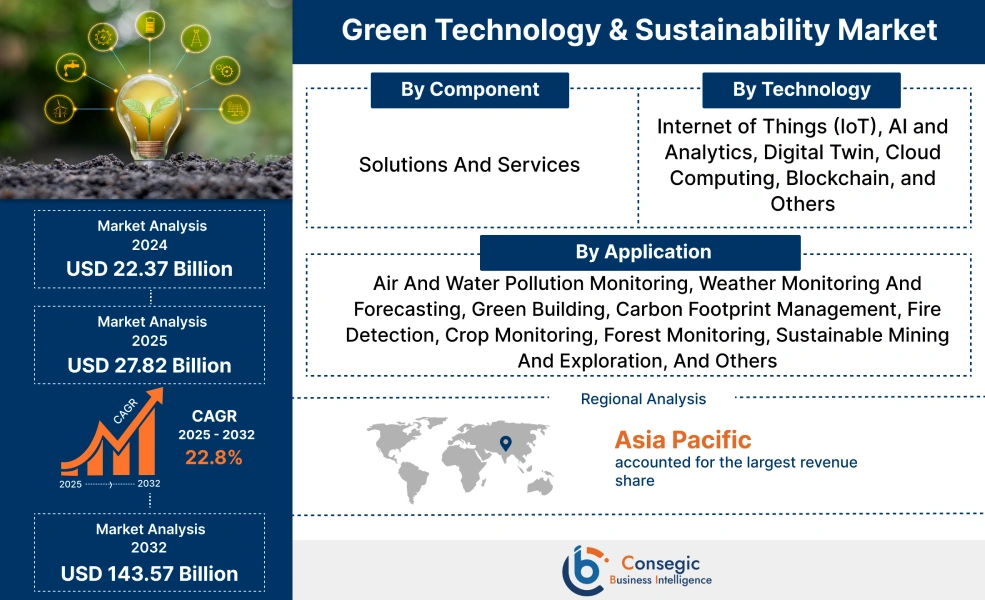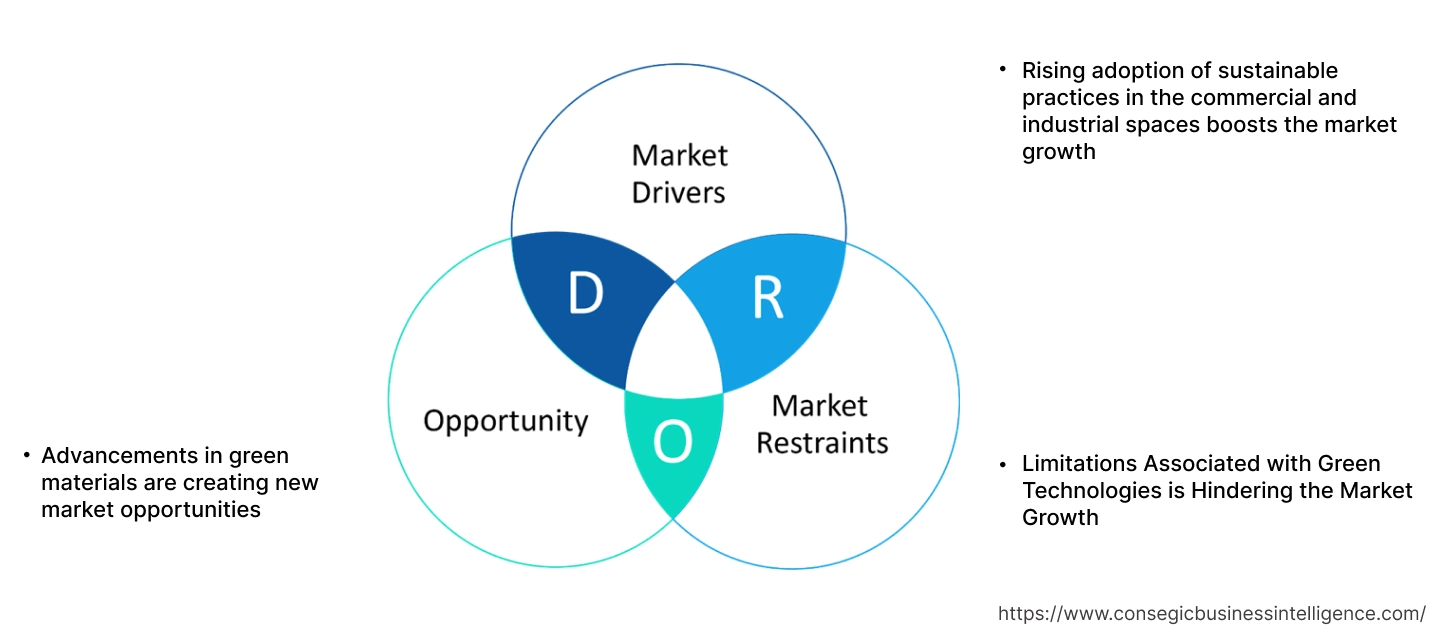Green Technology & Sustainability Market Size:
Green Technology & Sustainability Market size is estimated to reach over USD 143.57 Billion by 2032 from a value of USD 22.37 Billion in 2024 and is projected to grow by USD 27.82 Billion in 2025, growing at a CAGR of 22.8% from 2025 to 2032.
Green Technology & Sustainability Market Scope & Overview:
Green technology, also known as green tech, is the application of technology and science to minimize human impact on the environment and promote sustainability. It encompasses a wide range of fields, including renewable energy, waste management, sustainable agriculture, and eco-friendly materials, all aimed at reducing pollution, conserving resources, and creating a more sustainable future.
Green Technology & Sustainability Market Dynamics - (DRO) :
Key Drivers:
Rising adoption of sustainable practices in the commercial and industrial spaces boosts the market growth
Green technologies and sustainable practices are increasingly being adopted in commercial and industrial spaces to reduce environmental impact and promote long-term sustainability. These practices encompass various aspects, including energy efficiency, renewable energy, waste reduction, and resource management. Implementing technologies like LED lighting, smart building management systems, and high-efficiency HVAC systems can significantly reduce energy consumption and operational costs. Utilizing renewable energy sources like solar, wind, and geothermal power can help reduce reliance on fossil fuels and lower carbon emissions. Implementing practices like recycling, composting, and waste-to-energy systems can minimize waste generation and promote a circular economy.
Thus, the aforementioned factors are boosting the adoption of green technology and sustainability in turn driving the green technology & sustainability market growth.
Key Restraints:
Limitations Associated with Green Technologies is Hindering the Market Growth
Green technologies offer promising solutions for sustainability, but their adoption faces several limitations, including high costs, lack of infrastructure, and regulatory hurdles. These challenges hinder the widespread implementation of eco-friendly technologies, despite their potential for environmental and economic benefits. Developing and implementing green technologies often requires significant upfront investments in research, development, and infrastructure. This is a major obstacle for businesses, particularly smaller ones, who may struggle to justify the immediate costs, even with long-term environmental benefits.
Thus, the market analysis shows that the aforementioned factors are restraining the green technology & sustainability market demand.
Future Opportunities :
Advancements in green materials are creating new market opportunities
Green technology and sustainable practices, including green materials, focus on minimizing environmental impact and promoting a sustainable future. This involves using renewable energy sources, reducing waste, and utilizing eco-friendly materials in various industries. Green materials are environmentally friendly, biodegradable, or have a reduced carbon footprint. These includes bamboo, recycled steel, and bio-based polymers. Fiber-reinforced Composites combine the strength of natural fibers with the durability of composite materials, offering a sustainable alternative to traditional plastics.
Thus, the ongoing advancements in green materials are projected to create green technology & sustainability market opportunities during the forecast period.
Green Technology & Sustainability Market Segmental Analysis :
By Component:
Based on the component, the market is segmented into solutions and services.
Trends in the Component:
- Rising adoption of services for sustainability to reduce carbon footprint, resource efficiency, costs savings is boosting the green technology & sustainability market size.
- Increasing demand for green technology solutions to optimize IT infrastructure and to reduce energy consumption and waste.
The solutions segment accounted for the largest revenue share in the green technology & sustainability market share in 2024.
- Green tech solutions span various areas, including renewable energy, waste management, and eco-friendly materials, aiming to minimize negative impacts and reduce resource consumption.
- Green technology plays a crucial role in developing and deploying renewable energy sources like solar panels, wind turbines, and hydroelectric systems.
- Green technology supports sustainable waste management practices through innovations like smart recycling bins and waste-to-energy systems.
- Green building practices incorporate sustainable materials, energy-efficient designs, and water conservation measures.
- Therefore, the aforementioned factors are driving the green technology & sustainability market growth.
The services segment is expected to register the fastest CAGR during the forecast period.
- Green technology and sustainability services encompass a wide range of offerings aimed at promoting environmentally friendly practices and solutions.
- These services include consulting, design, implementation, and maintenance of green technologies across various industries and sectors including solar, wind, hydro, and geothermal power systems.
- These services reduce environmental impact, conserve resources, and contribute to a more sustainable future.
- Thus, the aforementioned factors are expected to boost the green technology & sustainability market trends during the forecast period.
By Technology:
Based on the technology, the market is segmented into Internet of Things (IoT), AI and Analytics, Digital Twin, Cloud Computing, Blockchain, and Others.
Trends in the Technology:
- Rising demand for cloud computing in sustainability solutions for minimizing the environmental impact of IT infrastructure is boosting the green technology & sustainability market size.
- Increasing adoption of digital twin to enhance green technology and sustainability efforts by providing a virtual replica of physical systems, enabling real-time monitoring, simulation, and predictive modeling.
The Internet of Things (IoT) segment accounted for the largest revenue share of 31.80% in the green technology & sustainability market share in 2024.
- Green technology and sustainability are significantly advanced by leveraging the Internet of Things (IoT).
- This involves using IoT devices and technologies to monitor and optimize resource usage, reduce waste, promote renewable energy, and generally minimize the environmental impact of various sectors.
- IoT sensors provide real-time data on energy consumption, water usage, and resource utilization in various industries, allowing for more efficient management and reduced waste.
- IoT facilitate the integration of renewable energy sources by optimizing their use and monitoring their performance, making renewable energy more reliable and accessible.
- Therefore, the aforementioned factors are driving the green technology & sustainability market demand.
The AI and analytics segment is expected to register the fastest CAGR during the forecast period.
- Green technology and sustainability leverage AI and analytics to address environmental challenges and promote resource efficiency across various sectors.
- This includes optimizing energy consumption, managing waste, improving renewable energy systems, and monitoring environmental health.
- AI algorithms analyze large datasets to identify patterns and trends, enabling informed decisions about resource allocation and sustainability efforts.
- AI models are trained on historical data to predict future outcomes, helping organizations anticipate challenges and optimize their strategies.
- Thus, the aforementioned factors are expected to boost the green technology & sustainability market trends during the forecast period.
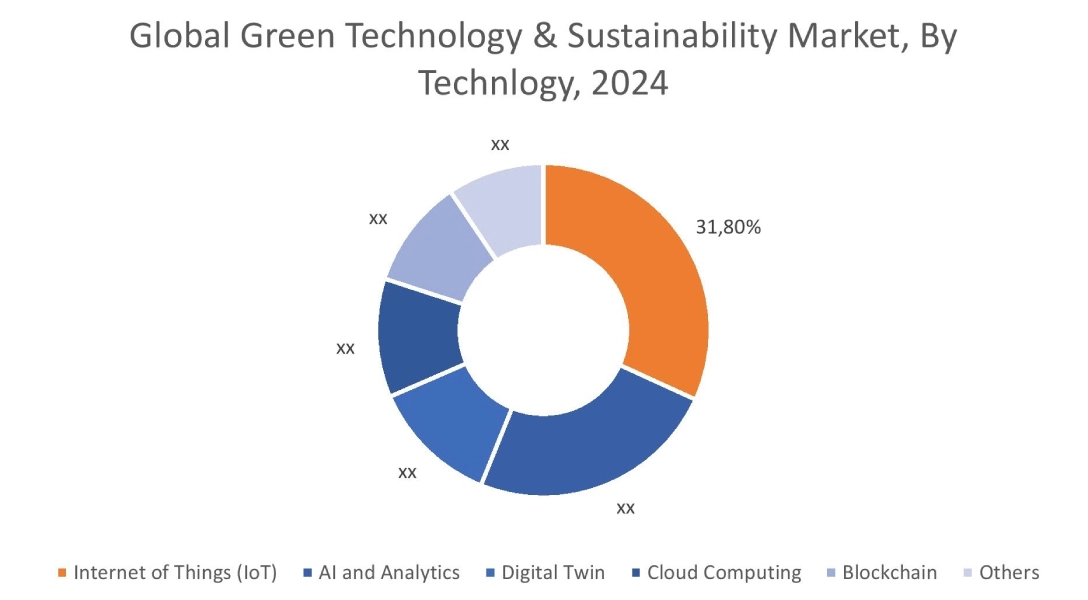
By Application:
Based on the application, the market is segmented into air and water pollution monitoring, weather monitoring and forecasting, green building, carbon footprint management, fire detection, crop monitoring, forest monitoring, sustainable mining and exploration, and others.
Trends in the Application:
- Rising adoption of advanced crop monitoring techniques that offer a powerful solution for improving agricultural efficiency and reducing environmental impact.
- Increasing demand for forest monitoring tools and techniques to improve efficiency, accuracy, and sustainability in forest management.
The air and water pollution monitoring segment accounted for the largest revenue share in the market in 2024.
- IoT-powered sensors are deployed in various locations to collect data on air pollutants like particulate matter, nitrogen oxides, and sulfur dioxide.
- Satellite-based technologies utilize remote sensing from space provides a broad overview of air quality, identifying pollution hotspots and tracking pollution trends.
- Fingerprint spectrum technology analyzes the unique chemical signatures of pollutants in water, enabling the identification of their sources and tracing their pathways.
- Satellites detect water quality changes, including algae blooms, sediment concentration, and temperature variations, allowing for large-scale water pollution monitoring.
- Therefore, the green technology & sustainability market shows that the aforementioned factors are driving the green technology & sustainability market expansion.
The green building segment is expected to register the fastest CAGR during the forecast period.
- Green building and green technology are intertwined in creating sustainable, eco-friendly constructions.
- Green buildings utilize green technologies, such as energy-efficient materials and systems, to minimize environmental impact and promote resource efficiency throughout the building's lifecycle.
- Green buildings often incorporate features like green roofs, energy-efficient lighting, renewable energy sources, and sustainable materials.
- Green buildings offer advantages such as reduced energy and water consumption, improved indoor air quality, enhanced occupant well-being, and increased property value.
- Thus, the aforementioned factors are expected to boost the green technology & sustainability market opportunities during the forecast period.
Regional Analysis:
The regions covered are North America, Europe, Asia Pacific, the Middle East and Africa, and Latin America.
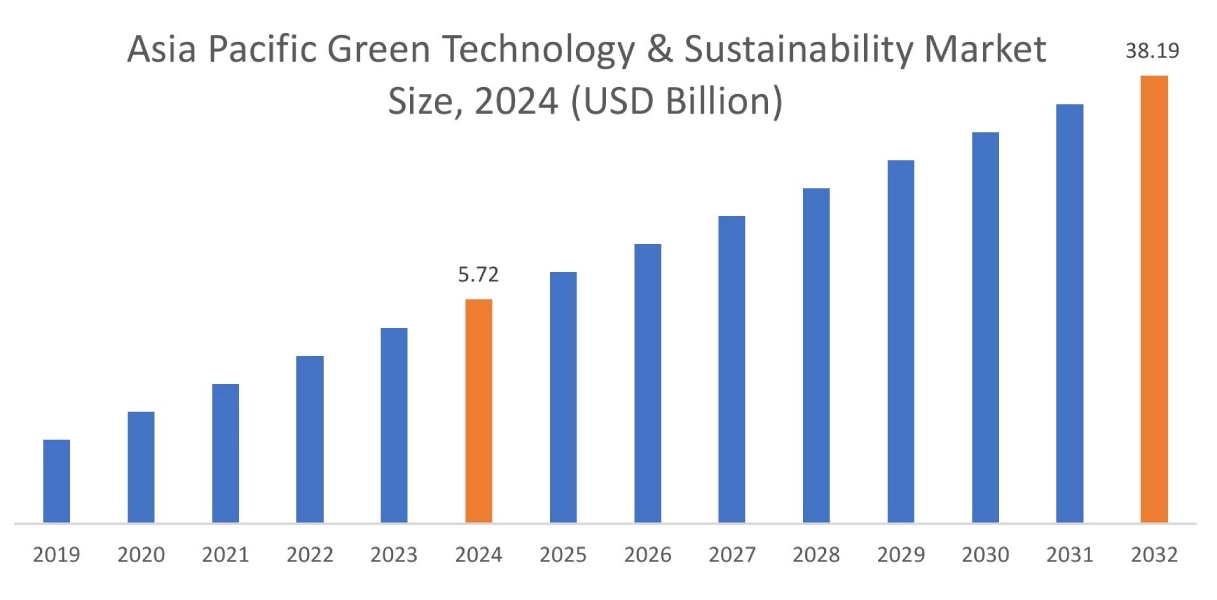
Asia Pacific region was valued at USD 5.72 Billion in 2024. Moreover, it is projected to grow by USD 7.14 Billion in 2025 and reach over USD 38.19 Billion by 2032. Out of this, China accounted for the maximum revenue share of 32.60%. The market growth is primarily driven due to rising environmental concerns, urbanization, and government policies aimed at reducing carbon emissions. Key factors fueling this growth include the abundance of renewable energy resources like solar and wind power, increasing consumer demand for eco-friendly products, and corporate social responsibility initiatives.
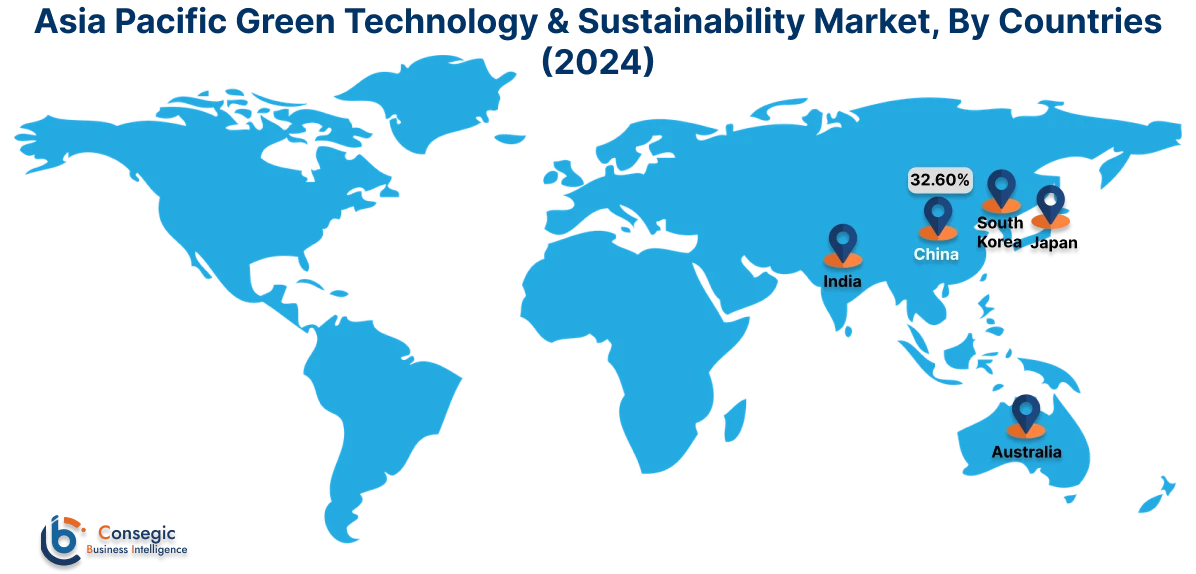
North America is estimated to reach over USD 60.73 Billion by 2032 from a value of USD 9.50 Billion in 2024 and is projected to grow by USD 11.82 Billion in 2025. The market in the region is primarily driven due to rising investments in sustainable technologies and buildings, rising adoption of sustainable practices by companies, and others. Thus, the green technology & sustainability market analysis shows that the aforementioned factors are boosting the market trends in the region.
In Europe, the market is driven by the European Green Deal, the Net-Zero Industry Act, and the EU's commitment to carbon neutrality by 2050. These initiatives encourage renewable energy, energy efficiency improvements, and sustainable practices, supported by regulations like the EU Taxonomy for Sustainable Activities and the Carbon Border Adjustment Mechanism (CBAM). Moreover, in Latin America, Middle East and Africa, the market is driven by abundant renewable energy resources, government initiatives, rising public awareness, and technological advancements. Thus, the aforementioned are boosting the green technology & sustainability market expansion in the regions.
Top Key Players and Market Share Insights:
The green technology & sustainability industry is highly competitive with major players providing solutions and services to the national and international markets. Key players are adopting several strategies in research and development (R&D), product innovation, and end-user launches to hold a strong position in the global green technology & sustainability market. Key players in the green technology & sustainability industry include -
- General Electric Vernova (USA)
- Consensys (USA)
- CropX (Israel)
- IBM (USA)
- Enviance (USA)
- Trace Genomics (USA)
- Sensus (USA)
- Taranis (USA)
- LO3 Energy (USA)
- Enablon (USA)
Green Technology & Sustainability Market Report Insights :
| Report Attributes | Report Details |
| Study Timeline | 2019-2032 |
| Market Size in 2032 | USD 143.57 Billion |
| CAGR (2025-2032) | 22.8% |
| By Component |
|
| By Technology |
|
| By Application |
|
| By Region |
|
| Key Players |
|
| North America | U.S. Canada Mexico |
| Europe | U.K. Germany France Spain Italy Russia Benelux Rest of Europe |
| APAC | China South Korea Japan India Australia ASEAN Rest of Asia-Pacific |
| Middle East and Africa | GCC Turkey South Africa Rest of MEA |
| LATAM | Brazil Argentina Chile Rest of LATAM |
| Report Coverage |
|
Key Questions Answered in the Report
How big is the green technology & sustainability market? +
Green Technology & Sustainability Market size is estimated to reach over USD 143.57 Billion by 2032 from a value of USD 22.37 Billion in 2024 and is projected to grow by USD 27.82 Billion in 2025, growing at a CAGR of 22.8% from 2025 to 2032.
What are the major segments covered in the green technology & sustainability market report? +
The segments covered in the report are component, technology, application, and region.
Which region holds the largest revenue share in 2024 in the green technology & sustainability market? +
North America holds the largest revenue share in the green technology & sustainability market in 2024.`
Who are the major key players in the green technology & sustainability market? +
The major key players in the market are General Electric (USA), Trace Genomics (USA), LO3 Energy (USA), IBM (USA), Enablon (USA), Enviance (USA), Sensus (USA), Taranis (USA), Consensys (USA), and CropX (Israel).
